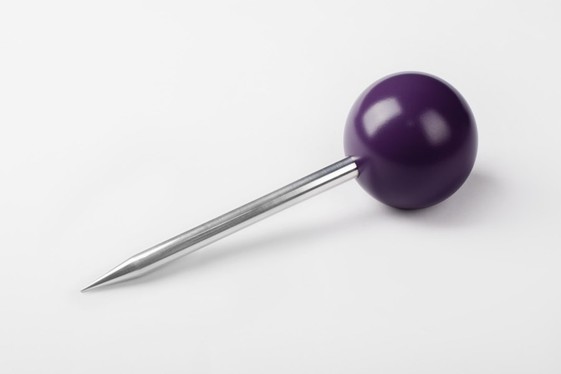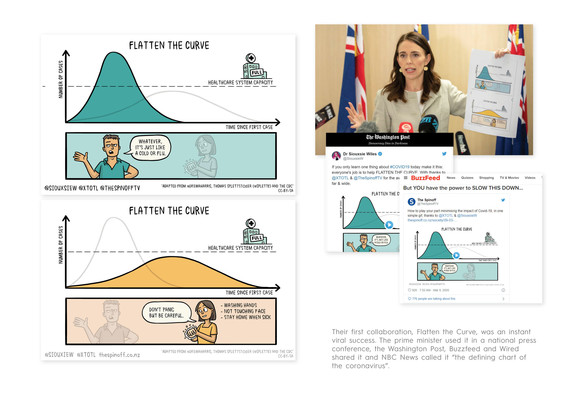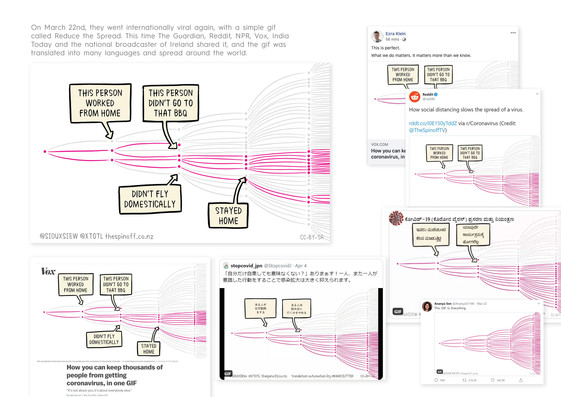The very best project in each discipline at the Best Design Awards is awarded the supreme, Purple Pin for work that truly raises the bar for New Zealand design.
Purple Pin Case Study — Public Good
The Spinoff
Covid 19 - Siouxsie and Toby



Toby Morris, The Spinoff
Purple Pin 2020
Public Good: Covid 19 - Siouxsie and Toby
Studio: The Spinoff
The Client
Readers of The Spinoff, a New Zealand online magazine and news site. It is known for current affairs coverage, political and social analysis, and cultural comment. Due to the viral nature of the work, the client became a wider, global audience.
The Challenge
The first stages of the Covid-19 pandemic were stressful and confusing. How does an online magazine cut through an online environment flooded with complicated and often conflicting information?
The Solution
The Spinoff decided to pair up infectious diseases and science communication expert Dr Siouxsie Wiles with cartoonist and illustrator Toby Morris. Their idea? To combine Dr Wiles’s scientific and communication skills with Morris’ ability to quickly and clearly explain complex information through simple illustrated gif animations.
The effectiveness of the pairing was clear immediately. Their first collaboration ‘Flatten the Curve’ was an instant viral success. The next day the Prime Minister Jacinda Ardern used it in a televised press conference, the Washington Post, Buzzfeed and Wired all shared it and soon NBC News called it "the defining chart of the Coronavirus”.
In the following weeks the pair continued to produce a regular stream of graphics that helped the New Zealand public understand the rapidly evolving situation and the new language that came with it, explaining concepts like ‘bubbles’, ‘social distancing’, ‘the lag’, the pros and cons of using masks and ‘contact tracing’.
Very quickly, the graphics began to be used by businesses, schools, universities and public organisations to communicate with staff, students and members. The United Nations High Commission for Refugees had the work translated into seven languages to distribute in refugee camps, and Somali versions were created for use in migrant communities in Europe.

In late March, they went internationally viral again, with a gif called ‘Reduce the Spread’.
The decision to present this information as design-led gifs was integral to their success. The work was produced quickly and shared even quicker. The gifs contained a whole message in one post - they were free and easy to share and perfect for a time where people are hungry for clear and accurate information, for themselves and to share with others, and are looking for that information on social media.
Their success proves the effectiveness of smart visual communication. They used visual metaphors and motion to demonstrate difficult-to-explain concepts like ‘exponential spread’ or ‘community transmission’ in a way that anyone from a small child to a stubborn grandparent could comprehend. The language was neither overly technical or overly simplistic, and the hand-drawn style was friendly, positive and human. It ultimately led the WHO to work with The Spinoff, an ongoing design-centric partnership covering Covid-19 across not only gifs but also video, infographics and data visualisations.
Looking back now, it's clear the pair's graphics did an incredible amount of public good, and almost certainly played a role in New Zealand's success in eliminating community transmission. The work and collaboration being released under creative commons meant that millions around the world were positively impacted by it.

Judges’ Comments
This design took a complex message and made it simple in any language.
In a highly volatile and confusing time the winning creative solution was simply executed and considered, achieving global reach, recognition and cut through.
In an environment where science and facts were highly contested these designs were able to provide complex information in an accessible, clear and concise fashion. They also helped inform New Zealand’s response and comparatively good Covid-19 statistics. Such a simple and human approach to a once in a lifetime problem.